|
Corporal George Simon took a deep breath, as the brothers approached the microphone.
For the first time in over fifteen years, Tommy Dorsey's orchestra would share the same
recording
studio with his brother Jimmy Dorsey's band, a special performance in New York's Liederkranz
Hall on March 15, 1945. In order to make sure both orchestras' sounds were properly recorded,
Simon had the respective brass sections set up at one side of the studio, the reed section on the
other side, and the rhythm sections in the middle. The feed to the mastering studio had to go
through two different radio network hookups just to get to the recording plant. "This resulted in
somewhat diminished fidelity," wrote Simon, "but the feeling came through."
For any big band devotee, this would be a historical recording, replete with newspaper stories
and
radio announcements. The track should have been saved and reissued on hundreds of Dorsey
greatest hits packages. But Simon was recording this for V-Disc Records, a government-created
music company. For him, this was just another recording session - albeit a historical one - and
the
two tracks produced today would end up in a box of 78's that were shipped overseas to GI's and
gunners and specialists and ensigns and generals and captains for free - recordings that were not
sold in Stateside record stores.
Radio personality Bill Goodwin introduced the festivities.
"Well fellows, we have two bands making this
V-Disc for you. One of them is led
by the
former boss of my present boss, a fellow named Tom Dorsey."
"Yeah, that's right, but tell me, who's this other character leading this other band?"
"Don't know him," said Goodwin.
"Wait a minute, I'm your brother Jimmy."
"Oh."
"Remember, we used to play together in the same band when we were kids?"
The trio continue to banter about old times, then discuss Bill Goodwin's involvement with
his
"new boss," Frank Sinatra. Simon smiles. He knows this introduction will mesh well with
whatever song the Dorseys perform.
Goodwin continues.
"Well fellows, how about cutting out the talk and
making a
little music
here for the lads, huh?"
"That's solid with me."
"That's solid with me, 'T' - let's go."
With that, both bands begin to play "More Than You Know" (V-Disc 451, Navy V-Disc
231),
and Tommy Dorsey's trombone and Jimmy Dorsey's clarinet blended like magic.
Such recording sessions are the hallmark of V-Disc Records, a label whose seven-year
existence
in the 1940's produced a treasure trove of rare jazz and big band tunes, patriotic marching music
and world-class classical orchestral performances. For a few years, thanks to a series of
musician's
union strikes, V-Disc was the only company able to produce new releases of popular songs.
American servicemen throughout the theater of war, from the Italian Alps to the North African
deserts, received a shipment of V-Discs every month, filled with a wide variety of music from
every different genre. Nine hundred 12-inch 78's, encompassing over 2700 songs. A few years
later, many of these discs were confiscated and destroyed by those same armed forces - but
today,
the records have survived, and the songs on those old 78's are resurfacing on compact disc.
The V-Disc program actually began in June 1941, six months before the United States'
involvement in World War II, when Captain Howard Bronson was assigned to the Army's
Recreation and Welfare Section as a musical advisor. Bronson, whose previous musical
experience included a stint in John Philip Sousa's marching band, suggested the troops might
appreciate a series of records featuring military band music, inspirational records that could
motivate soldiers and improve morale.
Bronson's original idea showed promise, and by 1942 the Armed Forces Radio Service
(AFRS)
sent 16-inch, 33 rpm shellac transcription discs to the troops, mostly radio shows with the
commercials edited out. The troops had no say in what they received - the transcription disc
could have a concert on it, or some big band music, or a symphony orchestra. And even then, at
least they arrived safely - as opposed to the shellac records their mothers and girlfriends sent
them
(over 80% of shellac 78's became jigsaw puzzles by the time they reached the soldiers).
Meanwhile, the American Federation of Musicians, under the leadership of James Caesar
Petrillo,
were upset. Petrillo argued that every time a record was played on the radio or in a jukebox, his
union members received neither compensation nor remuneration. With that in mind, Petrillo told
the four major record companies (RCA Victor, Decca, Columbia and Capitol) that unless AFM
members received a higher royalty payment to compensate for those losses, the union would not
produce any more records after July 31, 1942. The companies initially refused to pay the
increased royalty, and instead stockpiled performances and concerts, hoping that the strike would
be short.
It lasted for two years.
During the strike, musicians would give concerts and radio broadcasts, but made no recorded
music (a cappella groups were exempt from the ban, as were groups like the Harmonicats, whose
harmonicas were not considered "instruments" by Petrillo). The record companies quickly ran
out
of pre-strike unreleased material, and the demand for new songs was increasing dramatically
(Decca, for example, had the rights to release the soundtrack to the popular show "Oklahoma!" -
but no musicians would cross the picket line to record the album). And as the war raged on,
soldiers wanted to hear new songs and new singers, not the same pre-1942 recordings they heard
before they shipped off to the foxholes.
Now Lieutenant George Robert Vincent enters the picture. Vincent had a long association
with
both the armed forces and recorded music. He fought in World War I as a 17-year old lieutenant.
He later worked with Thomas Edison, designing improvements to the phonograph. By 1942, he
rejoined the Army and was assigned to the Armed Forces Radio Service as a technical officer,
and
worked with Bronson's 16-inch transcription discs.
Vincent knew the soldiers wanted to hear new music, so he asked his supervisors if a special
recording project could be undertaken that would provide new songs to the platoons. In July
1943, Vincent discussed the project with Major Bronson. Bronson okayed it, but told Vincent
that there was no money in the Army budget to start a record company. Undaunted, Vincent met
with the Army's fiscal officer, Major Howard Haycraft, who immediately allocated one million
dollars to Vincent's new project.
With money in hand, Vincent devoted all his time to the music program. He recruited Steve
Sholes, a former A&R man at RCA Victor who supervised jazz recordings by Sidney
Bechet
and
Jelly Roll Morton, to assist him. Vincent's record company now had a name - "V-Discs," a
sobriquet coined by Vincent's secretary. It also acquired a logo - a red-white-and-blue graphic
designed by a staff artist at Yank magazine on a $5 retainer.
The first problem was trying to find a suitable substitute for shellac, the main component for
records. Four out of every five transcription discs sent overseas arrived in pieces. And when the
Japanese took over French Indochina, America lost its supply of imported shellac. Although
shellac could be recycled and reused (and many Americans donated their old 78's in scrap drives
for war materials), the music was drowned out by the loud surface noise on recycled shellac
discs.
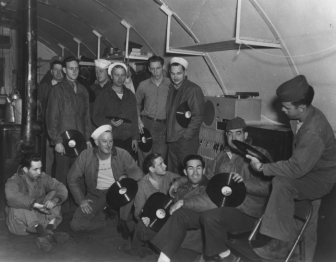 After much testing, Vincent's team found that
Vinylite, a
Union Carbide product, could be used as a viable
substitute for shellac. Because the Army also used
Vinylite for insulation and life rafts, V-Discs used a
second resin - Formvar, a Canadian-invented polyvinyl -
in conjunction with Vinylite (one of the companies that
pressed records for V-Disc, Columbia, refused to use
either compound, instead making V-Discs out of
whatever shellac they could allocate). After much testing, Vincent's team found that
Vinylite, a
Union Carbide product, could be used as a viable
substitute for shellac. Because the Army also used
Vinylite for insulation and life rafts, V-Discs used a
second resin - Formvar, a Canadian-invented polyvinyl -
in conjunction with Vinylite (one of the companies that
pressed records for V-Disc, Columbia, refused to use
either compound, instead making V-Discs out of
whatever shellac they could allocate).
After Steve Sholes joined the V-Disc project, two other
enlisted men signed on - Morty "Perfect Pitch" Palitz,
who spent his civilian life with Decca, Brunswick and
Columbia records; and Walt Heebner, a former RCA
sales department employee. Heebner's assignment was
to convince the AFM and Petrillo to grant a special waiver to record V-Discs for the Army.
On October 27, 1943, Petrillo wrote Heebner back with this letter:
"This will
acknowledge receipt of your letter of
October 25th containing request for
permission for our members to make records in connection with your V-DISC project ...
This is to advise you that the American Federation of Musicians interposes no objections to
the making and use of these recordings ... This letter also carries with it permission for
those members of the American Federation of Musicians, who are desirous of so doing, to
volunteer their services for the making of such recordings."
There were some conditions, though. Because of the AFM strike, Petrillo asked that the
recordings not be used for any commercial purposes; that the records not be sold; and that all
V-Discs were to be destroyed after the war. From that moment on, artists who wanted to record
now had an outlet for their productivity - as well as a guaranteed, receptive, enthusiastic
worldwide audience of soldiers and sailors.
Another key person, Sgt. Tony Janak, joined the project, and would stay with V-Disc
throughout
its existence. Janak, a former recording engineer for Columbia Records, produced special
V-Disc
"remote" recording sessions, setting up 400 pounds of "portable" recording equipment wherever
artists played - in concert halls, in jazz clubs, in apartments. "In the beginning," wrote Janak, "we
chose material from broadcasts and the files of the record companies that were contracting on the
project. Then we got into doing live sessions of our own: [we] were always dreaming up new
recording dates. We recorded at Columbia Records, RCA Victor, NBC, World, and Carnegie
Hall with Louis Armstrong, Tommy Dorsey, and Duke Ellington; jazz at the Metropolitan Opera
House and Stuyvesant Casino; at West Point with the Military Academy Band."
"Hello fellows, this is
Spike Jones. Special
Services
has asked us to do a record session for
you, so we couldn't get here fast enough, really. Here's some relaxation at 78 rpm."
-Spike Jones, introducing "Minka" and "McNamara's Band" (V-Disc 570)
The V-Discs were an instant hit overseas. Soldiers who were tired of hearing the same old
recordings were treated to new and special releases from the top bands of the day. And such a
varied selection - big band hits, some swing music, classical performances from the top
symphonies, a little jazz here and there, even some marching music to keep Major Bronson
happy.
Glenn Miller's orchestra even recorded a march version of W.C. Handy's "St. Louis Blues"
(V-Disc 65, Navy V-Disc 114) to make sure there was at least one march disc in the
monthly
shipments. And unlike the bulky 16-inch AFRS transcription discs, the 12-inch V-Discs were
perfect for listening pleasure in the mess hall, at the Officer's Club, even piped over loudspeakers
during recreation time.
Music for V-Disc came from almost everywhere. Radio networks sent airchecks and live
feeds to
V-Disc headquarters in New York. Some movie studios sent rehearsal feeds from the latest
Hollywood motion pictures to V-Disc. Artists gathered at several V-Disc recording sessions in
theaters around New York and Los Angeles, including CBS Playhouse No. 3 (currently the Ed
Sullivan Theater), NBC Studio 8H (the current home of "Saturday Night Live"), and CBS
Playhouse No. 4 (reborn in the 1970's as "Studio 54").
In 1943, Life commissioned a story on V-Discs, and photographer Gjon
Mili hosted an all-night
jam session in his apartment. Tony Janak and newly-promoted Captain Vincent were there to
record an all-star V-Disc combo. On horns - Wild Bill Davison, Bobby Hackett, Lou McGarity,
Benny Morton, Miff Mole, Irving Fazola, and Ed Hall. Duke Ellington sat at piano, and was
joined by Jess Stacy, Mary Lou Williams, James P. Johnson, and Teddy Wilson. Sid Catlett and
Cozy Cole played drums, and Josh White joined Eddie Condon on guitar. Singing for this group
were Josh White, Lee Wiley, and Billie Holiday. Although the music was as spectacular as those
combined artists could create, the acoustics in Mili's apartment were so harsh that none of the
songs recorded could be issued. The photographer, however, did get some nice shots of this
V-Disc All-Star band for Life (October 11, 1943).
"This is Arturo
Toscanini, conducting the NBC
Symphony Orchestra. We are pleased to be
able to convey to you through the medium of this V-Disc the stirring Garibaldi's
Hymn,
which represents the free spirit of the Italian people." (V-Disc
31)
In June 1944, the Navy joined the V-Disc program, under the tutelage of Lieutenant Ed
DiGiannantonio, known to friends as "DiGi." A talented recorder and ham operator in his youth,
DiGi used to record the Artie Shaw and Glenn Miller bands in his Boston hometown, then play
his homemade discs over his ham radio. While in the Navy, he fought at the battles of Wake
Island and the Coral Sea, and was on the heavy cruiser Vincennes when it sank near
Guadalcanal.
"When I got out of the hospital, I was assigned to a naval station in Bayonne, New Jersey, as a
technical liaison officer. About a year in that job, I got a call from a general in New York, he
said, 'DiGi, I looked at your background, and we would like you to join the V-Disc program.' I
said, 'General, I don't know what that is. My ship was sunk, and I'd rather get on a new ship and
go and fight again.' So they invited me up there, they told me what it involved was the recording
of all classes of music, from classical, semi-classical, jazz, swing, hillbilly, religious, and what
have
you. At first, I was reluctant, but nevertheless, upon the urging of my commanding officer, I
went
up there and took the assignment as the naval officer in charge of the V-Disc program in New
York City."
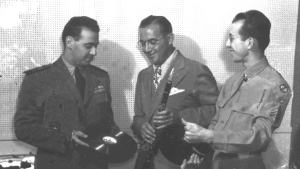 Every month, a V-Disc kit of 30 records was
sent from the RCA plant in Camden, to ports of
call and bases around the European and Pacific
theaters of operations. Inside the kit, along
with the V-Discs, was an assortment of steel
needles for the phonograph, a set of lyric
sheets, and a questionnaire that the soldiers
could fill out and return, asking what they liked
the best, what they liked the least, and what
they wanted to hear in the future. Four female
soldiers - two Army WAC's and two Navy
WAVE's - tabulated the thousands of letters
that came back from the front. Among all
requests, Bing Crosby's "White Christmas" was
the most popular song. As for non-holiday fare, the soldiers all wanted to hear "Stardust."
V-Disc obliged the request, and gave the soldiers "Stardust" as done by Artie Shaw (V-Disc
45),
Glenn Miller (V-Disc 65), Marie Greene (V-Disc 407, Navy V-Disc 187), Artie
Shaw again
(V-Disc 560), Edgar Haynes (V-Disc 681), and even a performance by the song's
writer, Hoagy
Carmichael (V-Disc 536). Every month, a V-Disc kit of 30 records was
sent from the RCA plant in Camden, to ports of
call and bases around the European and Pacific
theaters of operations. Inside the kit, along
with the V-Discs, was an assortment of steel
needles for the phonograph, a set of lyric
sheets, and a questionnaire that the soldiers
could fill out and return, asking what they liked
the best, what they liked the least, and what
they wanted to hear in the future. Four female
soldiers - two Army WAC's and two Navy
WAVE's - tabulated the thousands of letters
that came back from the front. Among all
requests, Bing Crosby's "White Christmas" was
the most popular song. As for non-holiday fare, the soldiers all wanted to hear "Stardust."
V-Disc obliged the request, and gave the soldiers "Stardust" as done by Artie Shaw (V-Disc
45),
Glenn Miller (V-Disc 65), Marie Greene (V-Disc 407, Navy V-Disc 187), Artie
Shaw again
(V-Disc 560), Edgar Haynes (V-Disc 681), and even a performance by the song's
writer, Hoagy
Carmichael (V-Disc 536).
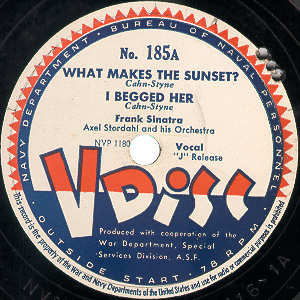 "We might get 4000 requests to hear Frank Sinatra sing 'That Old Black Magic,'" said DiGi.
"We'd go out to the coast, get in touch with Frank, and we'd arrange a session, usually at one of
the soundstages or one of the radio studios. And instead of doing just the one tune, we would do
perhaps 12 or 15 different songs, and having those Sinatra songs in the bank for future releases." "We might get 4000 requests to hear Frank Sinatra sing 'That Old Black Magic,'" said DiGi.
"We'd go out to the coast, get in touch with Frank, and we'd arrange a session, usually at one of
the soundstages or one of the radio studios. And instead of doing just the one tune, we would do
perhaps 12 or 15 different songs, and having those Sinatra songs in the bank for future releases."
"Hiya men, this is
Frank Sinatra. I hope you like
these tunes that I've chosen to do for you
on these very wonderful V-Discs. And I hope you get as much of a kick out of hearing
them as I do out of singing them for you."
- Frank Sinatra, introducing "That
Old Black Magic" (V-Disc 722)
"The first session I was ever involved with," said DiGi, "was a Sinatra session in Hollywood.
What got me was the fact that no one else in the band was playing the melody, and Frank was up
there singing the whole melody by himself - of course, he had perfect pitch - and he was in a way
like Toscanini, if a guy in the band made a mistake, he could pick it up. The guy at the time was
very friendly, very cooperative, he never turned us down for any session we did. No one ever
gave Frank Sinatra credit for all his contributions during World War II. He made close to 70
recordings, all at the request of GI's."
Because the 12-inch V-Discs could hold up to six minutes of music per side, it allowed more
flexibility and longer jams from jazz artists and big bands. "When a lot of these guys recorded in
the studio," said DiGi, "they did it under a very staid condition. When they did V-Discs, some
of
them already had a couple of shots and were warmed up. It was very informal, and the things
just
rocked. If they wanted to jam for six minutes, we could do it."
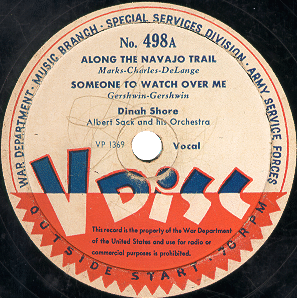 Sometimes the atmosphere was too loose. The songs and lyrics on V-Discs had
to be so clean as
to not offend a general (or his wife). Even words like hell and damn
were excised from V-Discs.
Only half of Fats Waller's V-Disc recording sessions ever reached pressing stage - "Ain't
Misbehavin'" got pressed, but not "You're A Viper (The Reefer Song)." "We did the session with
Fats Waller," said DiGi, "we did about 22 selections. When he first got to the studio, he
demanded a bottle of VAT-69, which is not hair tonic. And he started playing the piano, and he
was okay for a while. Then he consumed the second bottle, and out of the 22 songs, we only
used about 8 or 9 of them, because he got very sloppy and started using a few words you
shouldn't use. The last records Fats Waller ever made were V-Discs. Then he went out to
California, and on the way back from Los Angeles he died on the Super Chief train. So we have
those final records of Fats Waller." Sometimes the atmosphere was too loose. The songs and lyrics on V-Discs had
to be so clean as
to not offend a general (or his wife). Even words like hell and damn
were excised from V-Discs.
Only half of Fats Waller's V-Disc recording sessions ever reached pressing stage - "Ain't
Misbehavin'" got pressed, but not "You're A Viper (The Reefer Song)." "We did the session with
Fats Waller," said DiGi, "we did about 22 selections. When he first got to the studio, he
demanded a bottle of VAT-69, which is not hair tonic. And he started playing the piano, and he
was okay for a while. Then he consumed the second bottle, and out of the 22 songs, we only
used about 8 or 9 of them, because he got very sloppy and started using a few words you
shouldn't use. The last records Fats Waller ever made were V-Discs. Then he went out to
California, and on the way back from Los Angeles he died on the Super Chief train. So we have
those final records of Fats Waller."
Even the introductions had to be carefully monitored. One unreleased Glenn Miller
introduction
was interrupted by a falling sheet music stand (and Miller's response: "Jesus Christ, what was
that..."). DiGi recalls one session where Bing Crosby, the epitome of cool, let down his guard in
a rare public display of earthiness. "There was one particular session where we're doing it with
Bing Crosby, and one of the most famous guitar players in the world was a guy named Tony
Mottola. And he started playing the introduction to one of Bing's songs, and he missed a note.
And Bing said, 'Tony, take your #%@*! gloves off!' And no one knew Bing had said that, and
when we played it back, of course the place was in an uproar for a couple of minutes - here was a
genius making a flub that doesn't happen that often."
"Hello men. This is
Donald Mills. My brothers
and
I are here in the studio making a few
V-Discs for all of you. And we want you to know that we sure hope you have as much fun
listening to them as we have in making them for you ... Good luck to all of
you."
- introduction to "You Tell Me Your Dreams," (V-Disc 452, Navy V-Disc
232)
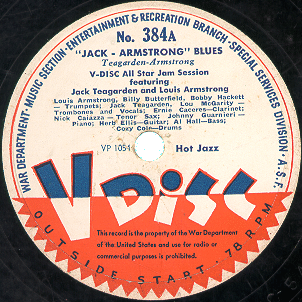 By 1944, Captain Vincent found a new way to make the public aware of the V-Disc project -
as
well as make new recordings for the servicemen at the same time. "For The Record," a program
broadcast on New York's WEAF and simulcast through the NBC network, had a rotating
orchestra, master of ceremonies and vocalists throughout its seventeen-week summer run.
Overseeing this new project was a new member of the V-Disc project, Cpl. George Simon, a
music writer for Metronome magazine who had played drums for the Glenn Miller
Orchestra in
the 1930's, and who knew almost every jazz musician and band member on a first-name basis. By 1944, Captain Vincent found a new way to make the public aware of the V-Disc project -
as
well as make new recordings for the servicemen at the same time. "For The Record," a program
broadcast on New York's WEAF and simulcast through the NBC network, had a rotating
orchestra, master of ceremonies and vocalists throughout its seventeen-week summer run.
Overseeing this new project was a new member of the V-Disc project, Cpl. George Simon, a
music writer for Metronome magazine who had played drums for the Glenn Miller
Orchestra in
the 1930's, and who knew almost every jazz musician and band member on a first-name basis.
"During my fifteen or so months on the V-Disc job," wrote Simon, "I contacted and recorded
Benny Goodman, Woody Herman, Count Basie several times, Louis Armstrong and a bunch of
all-stars, and, at a session that turned out to be the most exciting of all my V-Disc ventures, the
combined bands of Jimmy and Tommy Dorsey ... Ella Fitzgerald with a backup group that
included Buddy Rich (when, for the first time that I know of, she scatted a chorus, at her
suggestion) ... I did have the privilege of directing that Monday night 'For The Record' NBC
radio
series, for which I contacted many of the artists."
While most record companies frowned upon the "sharing" of artists on record, the AFM
strike
had an unexpected benefit to the V-Disc project - it allowed artists who hadn't worked together in
years to combine their talents in a special release for the boys overseas, without being shackled
by
the restrictive contracts of their respective record companies. Such one-of-a-kind performances
that were captured on V-Disc include:
- Tommy Dorsey performing "Somewhere Over The Rainbow", with guest vocalist Judy
Garland (V-Disc 335; Navy V-Disc 159).
- Ella Fitzgerald scatting with Buddy Rich's orchestra on a version of "Blue Skies," where
both
Fitzgerald and Rich scat through whatever lyrics they didn't remember (V-Disc
775).
- Fats Waller teasing Paul Robeson, suggesting that the famed actor/singer make some
V-Discs
for the troops (on "Too Sleepy People," V-Disc 32), not realizing that Robeson had
included
two gospel recordings in the very same V-Disc kit ("Deep River" and "I'm Going To Tell God
All My Troubles," on V-Disc 51).
- Abbott and Costello doing "Who's On First," on a V-Disc packaged with Brooklyn Dodgers
organist Gladys Gooding playing a baseball medley (V-Disc 741).
- An all-star jazz session, sponsored by Esquire magazine, that created the
greatest jazz combo
of its day - Louis Armstrong, Roy Eldridge, Jack Teagarden, Coleman Hawkins, Art Tatum,
Red Norvo, Lionel Hampton, Big Sid Catlett, Oscar Pettiford, Al Casey and Barney Bigard
("Mop Mop" and "Rose Room," V-Disc 152).
V-Disc received other jazz performances from Mildred Bailey's CBS radio shows, "Mildred
Bailey and Company," and "Music Till Midnight." Sunday afternoon concerts of the New York
Philharmonic were sent by line from WABC to the V-Disc studios. In November 1944, Captain
Vincent organized a special "V-Disc Treasury All-Star Performance" at Constitution Hall, and
sold over $3 million in War Bonds - and garnered a few new tracks for V-Disc's archives.
During the first week of the V-Disc project, 1,780 boxes of 30 V-Discs and assorted needles
were
shipped to Ports of Embarkation, and from there to the troops. Within a year, production of the
V-Discs tripled, so that the Navy, Air Force, Marines and Coast Guard would have enough
V-Discs of their own. By 1945, more than 4 million records had been shipped from the Camden
plant (along with 125,000 spring-wound V-Disc brand phonographs, and billions of steel
needles).
Even the Office of War Information and Office of Inter-American Affairs wanted V-Discs - they
were used by shortwave operators as propaganda materials to Latin American and European
countries; a counterbalance to Axis Sally and Tokyo Rose.
As the war reached a close, so too did the AFM union strike - the four major record
companies
capitulated to Petrillo's demands, and increased their royalty payments to the AFM rank and file.
But AFM members continued to record for V-Disc, as part of their patriotic duty to the soldiers
and seamen.
Glenn Miller and his orchestra was part of that patriotic duty. The first V-Disc kit had Glenn
Miller recordings in it, taken from RCA Victor and Bluebird sessions recorded before the AFM
strike. After accepting a commission from Major Bronson of the Music Division, he later
formed
the 418th Army Air Force Training Command Orchestra, and began a series of
broadcasts from
Yale University over CBS's network. The program, "I Sustain The Wings," caught the attention
of V-Disc officer Ed DiGiannantonio, who had recorded Miller in the 1930's for DiGi's ham
radio
broadcasts.
"I built a recorder, and I bought little aluminum discs, they were about 8 inches in diameter,
made
by Presto. And the reason why I made the recordings in the first place, was as a ham, when you
got on the air, you used to call CQ, CQ, meaning you want to talk to someone. I got a little lazy,
so I made a recording. I would play the record, then take it off and talk to someone in Europe or
what have you. So I thought, why not record the bands? I really didn't expect anything to
happen, but I got a good reaction from guys like Artie Shaw and Glenn Miller and Benny
Goodman. I paid 90 cents for the blank, and I sold the records to those guys for two and a half
bucks. I still have here one of the records I made for Glenn Miller in April 1937. So I walked
into his studio while he was recording for 'I Sustain The Wings,' and he looked at me, he said,
'DiGi, what are you doing here?' I said 'Glenn, I'm a naval officer in charge of the V-Disc
program.' So we recorded Glenn Miller's V-Disc sessions between the three hour gap for the east
coast and west coast broadcasts, and we became very dear friends."
"This is Captain
Glenn Miller, speaking for the
Army Air Force Training Command
Orchestra, and we hope that you soldiers of the Allied Forces enjoy these V-Discs that
we're making just for you."
- Glenn Miller, introducing "Stardust" (V-Disc 65)
During one session in October 1944, the Glenn Miller band traveled to the RCA Victor
studios in
New York for a special V-Disc recording session. The session was memorable to another
V-Disc
officer - after one of the recordings, Private Steve Sholes informed Miller that the orchestra's first
trumpet was flat. Captain Miller was not amused. "Naturally, he really burned me
to
a cinder,"
wrote Sholes.
Still, Miller and his orchestra recorded over 60 tracks for V-Disc, culled from special
sessions
and
from his radio broadcasts. When Glenn Miller died in a plane crash in December 1944, the
music
world lost one of its great bandleaders - and the V-Disc program lost one of its most ardent
supporters.
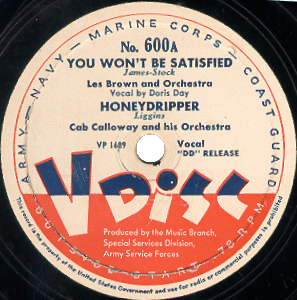 When the war ended in 1945, some of the V-Disc officers drifted away from the original project. DiGiannantonio was promoted to the Entertainment Section of the Navy's Liaison Unit, and oversaw not only V-Discs, but also the USO shows. Steve Sholes went back to RCA after his
discharge, recording and producing Dizzy Gillespie and Coleman Hawkins, signing Chet Atkins as his assistant, and recommending that RCA sign this kid from Tennessee named Elvis Presley. When the war ended in 1945, some of the V-Disc officers drifted away from the original project. DiGiannantonio was promoted to the Entertainment Section of the Navy's Liaison Unit, and oversaw not only V-Discs, but also the USO shows. Steve Sholes went back to RCA after his
discharge, recording and producing Dizzy Gillespie and Coleman Hawkins, signing Chet Atkins as his assistant, and recommending that RCA sign this kid from Tennessee named Elvis Presley.
Walter Heebner also returned to RCA Victor, working in its Hollywood division. He later
created his own record label and tape cartridge division, and assisted in a project where
19th-century player piano rolls were transferred to records. George Simon returned
to Metronome
magazine, worked with the Newport Jazz Festival, and became Executive Secretary of NARAS.
As for Captain Vincent, he was promoted to Major and received the Legion of Merit award
for
his services with the V-Disc project. He later designed the vast multilingual translation complex
for the Nuremberg War Crimes trials, and installed a similar electronic multilingual translation
system into the new United Nations building.
Sergeant Tony Janak remained with V-Disc - Major Bronson and the Army felt V-Discs was
too
important to the close down just yet. Even after his discharge in 1946, Janak kept producing and
recording V-Discs throughout the latter half of the decade, as the Marshall Plan kept soldiers
stationed in faraway lands. He still supervised specialized recording sessions for V-Discs, and
contracted with various radio networks for dress-rehearsal feeds. He created a special radio
program on New York's WNEW, the "WNEW Saturday Swing Show," that would provide new
swing and jazz tunes for the V-Discs.
"This is Colonel
Bronson, Chief of the Music
Branch. We know what a great many of you
will think when you see the Christmas appearance of this package of V-Discs, because a lot
of us have been overseas too. We have included Christmas selections in this seemingly
early release because, in past years, some outfits received them a little late. This year we
want to make sure that every one of you, all the way out to the end of the line, have them
for the holiday season ... The men who make V-Discs: Sergeant Janak, Sergeant Reed,
Private Brenner, Frank Bruno and all of us here in the Music Branch join your buddies and
the grateful citizens of our beloved country in wishing you a sincere, very Merry Christmas.
And now, Nelson Eddy, with Robert Armbruster's orchestra and chorus, will perform The
Twelve Days of Christmas." (V-Disc 651)
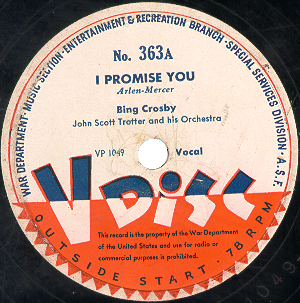 But as the years wore on, V-Discs became more expensive to produce. The original 30-disc
kit
became a 20-disc kit in February 1944, but that was so the Army could send more boxes
overseas. In September 1945, the kit content was reduced from twenty discs to fifteen. One year
later, the kits were reduced to ten records apiece, and were sent on a "request-only" basis. In
November 1947, the monthly shipments were decreased to every other month. But as the years wore on, V-Discs became more expensive to produce. The original 30-disc
kit
became a 20-disc kit in February 1944, but that was so the Army could send more boxes
overseas. In September 1945, the kit content was reduced from twenty discs to fifteen. One year
later, the kits were reduced to ten records apiece, and were sent on a "request-only" basis. In
November 1947, the monthly shipments were decreased to every other month.
And to make things more difficult, the record companies who originally pressed records for
V-Disc now treated it like a competitor. During the war, RCA and Columbia opened their
musical libraries and archives for V-Disc. Now, Tony Janak had to fill the V-Disc kits with
more
live recordings and radio feeds, just to get today's top hits. By using these outlets, wrote Janek,
V-Disc "could get new, up-to-the-minute popular songs - [we] obviously couldn't get them from
the commercial companies with whom [we] essentially were in competition."
In May 1949, the final kits - a box of ten discs containing tracks from Sarah Vaughan, Tex
Ritter,
Buddy Rich, Duke Ellington, Frank Sinatra and Leopold Stokowski - were the final records ever
released by V-Disc.
After the V-Disc program ended in 1949, the Armed Services set out to honor the original
AFM
request that the records not be used for commercial purposes. Original masters and stampers
were destroyed. Leftover V-Discs at bases and on ships were discarded. On some occasions, the
FBI and the Provost Marshal's Office confiscated and destroyed V-Discs that servicemen had
smuggled home. An employee at a Los Angeles record company even did some jail time - his
crime was the illegal possession of over 2500 V-Discs.
But some clear heads surfaced above the madness. The Library of Congress has a complete
set of
V-Discs, and the National Archives did save some of the metal stampers. Another nearly
complete set of V-Discs was gathered through the work of Lieutenant DiGiannantonio. "I
reported to a captain, he said to me, 'DiGi, I want you to keep a copy of every one of these Navy
records, and in case anything happens, we've got a copy.' So I said 'Yes sir.' So I had these
special cabinets made, and I put them in shelves and in dust-proof containers. After the V-Disc
program ended, and I got reassigned, I asked, 'Captain, what do you want me to do with these
things?' He said, 'I don't know, take them home.' So I took them home."
Those custom-made shelves and dust-proof containers saved DiGi's collection in 1954, when
Hurricane Carol tore through the New England coast. DiGi's basement was flooded with eight
feet of water, and priceless artifacts of the V-Disc project - photos of him with the various artists,
meticulous notes about performers and recording studios - were washed into the Charles River.
But the record cabinets withstood the hurricane, protecting his V-Discs to this day.
In 1978, Ed DiGiannantonio began a new odyssey, talking to military and musical
organizations in
an effort to legally re-release the V-Discs to American listeners (some bootleg albums with
scratchy V-Disc transcriptions appeared in the early 1970's, mostly from Europe). It took him
twelve years of calls and redirects, but by 1990 he was able to release a three-cassette series of
popular V-Disc recordings, many with the original introductions, all mastered from his original
78's. "Now the big question that has never been resolved, is whether or not some of these artists
are due royalties. I've set up an escrow fund just in case, but since they volunteered their
services,
and the record companies volunteer their services, I've never had anybody ask for money. But in
case they do, I can say if I owe you a dime a record, I'll do it. I've been completely honest and
completely above board in every single thing I've done in this project."
Today, DiGi supervises a line of V-Disc compact discs, distributed through the Collector's
Choice
music catalog. Those artists who gave their time and talent - Benny Goodman, Tommy Dorsey,
the Andrews Sisters, The Three Suns - now have their patriotic recordings available on CD. "I
knew a guy in Richmond, a fellow named Walt Smith, and he called me about a V-Disc - he
heard
about me on radio talking about them. He told another guy in South Carolina about me, and this
guy called Richard Perlman, who was president of Movie Play USA, a subsidiary of a worldwide
distribution company. And the next thing I knew, I got a call from Richard Perlman, who talked
to me and said 'DiGi, I want to do a V-Disc program with you.' We put out two volumes, and
we're about to put out the third volume, as well as compilations of various artists on V-Disc."
And DiGiannantonio has one final mission in life - as the last surviving officer of the V-Disc
project, he would like to make sure both the musicians who gave their time and talents to the
V-Disc project, and the servicemen in the Music Division who recorded, produced, gathered and
released the titles to soldiers and seamen around the world, receive the recognition and honor
they
are due. "Right now, I don't know when I'm going to die, but the last thing I would like to do is
give some publicity to the musicians and the record companies and everybody else for their
contributions that they gave during World War II for this music. No one has ever said, 'Hey
guys,
you did a fantastic job, and the country thanks you.' It's long overdue. There's not that many of
these guys that are still alive. No one has ever thanked any of the artists who contributed their
talents, and with these releases, I would like very much to be able to do that."
"Hello fellows. I'm
awfully glad we got to make
these records for you. And ... I'm the one
who's doing the ravioli. So hurry on home, will you?"
- Lily Ann Carol,
introducing Louis Prima's "I'll Walk Alone" (V-Disc
525)
EPILOGUE:
Lt. Edmond DiGiannantonio passed away on February 19, 2000, after a long battle with prostate cancer, and was buried with full honors at Arlington National Cemetery. He remainded dedicated to his V-Discs throughout his life, and a nation of music lovers will always appreciate his efforts to preserve this portion of music history.
ACKNOWLEDGMENTS:
This article could not have been written without the assistance of the book "V-Discs: A History
and Discography," written by Richard S. Sears (© 1980, Greenwood Press, Westport,
Connecticut), and personal interviews with Lt. Ed DiGiannantonio, Commander, United States
Navy (Ret.), and Gordon Anderson at Collector's Choice. Other information came from Art
Hilgart's article in the Journal of the International Association of Jazz Record
Collectors The
assistance of the thousands of artists, musicians, singers, writers and performers, along with the
servicemen who recorded, produced and created the V-Disc records, is greatly appreciated.
Write an e-mail to the author of this article
|

